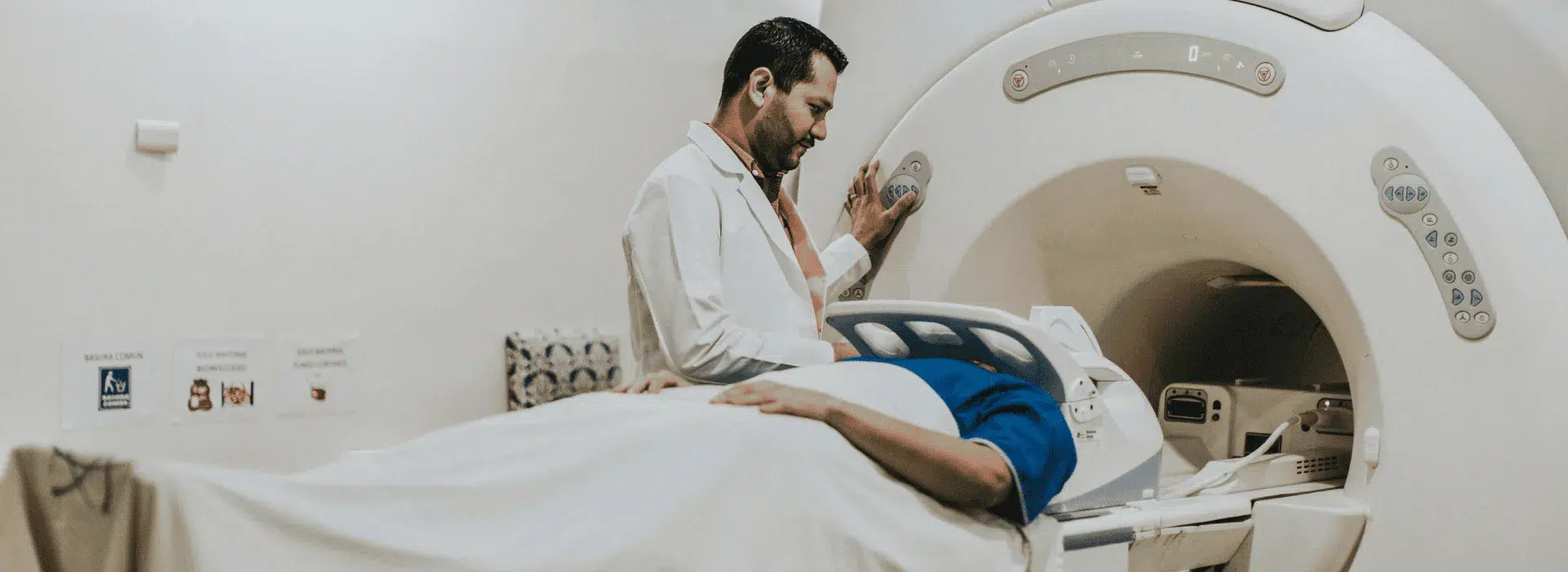Contents

Usually when the term “X-ray” is discussed during a conversation with a healthcare professional, they are referring to a “plain radiograph”, which is often used for things such as detecting broken bones, assessing joints (for example, to identify signs of arthritis) and identifying lung conditions such as pneumonia or lung cancer.
An X-ray is a type of electromagnetic radiation, like microwaves, radio waves and visible light, but at a much higher energy level than these. X-rays can pass through objects and in the medical world, computed tomography (CT) scans and mammograms during breast screening also use X-rays. X-rays are also used to treat some cancers - “radiotherapy”.
X-ray energy moves in streams or particles called “photons” and due to their high energy levels, they move much quicker than the speed of light. These photons are most often not detectable by human senses, unless you are exposed to large amounts of radiation. If you have a large amount of exposure over a short period of time this can cause radiation sickness. This type of poisoning can lead to symptoms such as a change in bowel habit, vomiting, fatigue, an altered mental state such as confusion, skin changes, dizziness and hair loss.
Repeated exposure to radiation over a more prolonged period can cause harm to our body’s cells. A common example of this is sunburn caused from ultraviolet (UV) radiation damaging skin cells & causing redness (erythema) around the affected area. Radiation burns can also occur within the medical field - radiation dermatitis is inflammation of the skin in patients receiving radiotherapy.
When cells are damaged by radiation, our body’s natural defences (immune system) will often start a repair process. However, on occasions, radiation can significantly impact DNA. DNA carries genetic material & can be considered as a “set of instructions” inside every living cell to tell it how to function and grow.
When DNA is damaged it can cause cells to grow & divide uncontrollably and in some cases, this leads to cancer. The risk of DNA damage will increase with high levels of radiation exposure or repeated episodes of exposure, and cancer can develop decades after the exposure to radiation.
Humans are exposed to background radiation every day. The largest source of background radiation comes from soil and certain rocks - gases (such as radon) can be released and certain elements which make up rocks (such as uranium) can become unstable and release particles into the atmosphere. These have enough energy to potentially harm our body’s cells. Outdoor air contains very low radon levels, however within enclosed spaces the levels can be higher (for example, underground caves and mines, which can be poorly ventilated). Radon is measured by specialised monitors and a nationwide survey in the 1990s found the average radon concentration in Australian homes to be around 10 becquerels per cubic meter (Bq/m³), which is significantly lower than the global average. Humans can also get background radiation from food, water and cosmic radiation emitted from Outer Space.
Feeling sick and unsure why? Speak with a GP online in 15 minutes.
See a Doctor now
Available 24/7, across Australia.
Experts use the sievert unit (or the smaller milisievert - mSv) to quantify the impact of radiation on our body. The worldwide natural dose to humans is about 2.4mSv each year and In Australia it is between 1.5mSv - 1.8mSv on average. As the average life expectancy in Australia is 83, it would be safe to assume the average lifetime exposure to background radiation could reach almost 150mSv. Scientific research states that the risk of cancer noticeably increases after exposure to 100mSv, however it is important to note that acute radiation exposures are estimated to be about 1.5 to 2 times more effective in causing health effects compared to prolonged exposure. Medical research has not been able to accurately quantify the cancer risk for exposures less than 100mSv, but it is quite probable that exposure to 10-100msV will have some negative impact on health.
Globally, 1% of all cancers are thought to be due to background radiation exposure alone. Modern day geiger counter apparatus can be used to display radiation levels of X- rays and experts have managed to develop the equivalence of various medical imaging to background radiation.
During CT imaging, a contrast dye is sometimes injected into a vein to enhance the visibility of certain body tissues. This can lead to a more accurate diagnosis but does increase the amount of radiation absorbed by the body.
Our online doctors at Hola Health are more than happy to discuss any questions or concerns you may have about radiation, including whether pursuing medical imaging is the right approach for you. Healthcare professionals are unlikely to recommend imaging which will expose you to radiation without carefully considering the risks & benefits. Most often, the risk of missing a potential diagnosis by choosing not to image would outweigh the small risk of DNA damage from radiation. This decision may be more difficult if you have already had a lot of medical imaging in the past or if a child is involved. Children’s bodies are developing quickly and are more sensitive to the effects of radiation.
| Procedure | Approximate effective radiation dose | Comparable to Worldwide average natural background radiation for: |
| Dental plain radiograph (X-ray) | 0.005 mSv | 18 hours |
| Chest plain radiograph (X-ray) with 2 views | 0.1 mSv | 15 days |
| Plain radiograph of an extremity (eg - foot X-ray) | Less than 0.001 mSv | 3.5 hours |
| Plain radiograph of lumbar spine | 1.3 mSv | 7 months |
| CT scan of lumbar spine | 6 mSv | 2.5 years |
| CT scan of brain | 1.6 mSv | 8 months |
| CT scan of chest | 6.1 mSv | 2.5 years |
| CT coronary angiography (CTCA) | 8.7 mSv | 3.5 years |
| CT scan of abdomen and pelvis | 7.7 mSv | 3 years |
Feeling sick and unsure why? Speak with a GP online in 15 minutes.
See a Doctor now
Available 24/7, across Australia.
What we treat
- Cough
- Nausea & vomiting
- Fever
- Hayfever
- Fatigue
- Sore throat
- Acne
- Hair loss
- Gout
- Eczema
- Rosacea
- Sunburn
- UTI
- Erectile dysfunction
- Contraception
- Morning sickness
- Morning after pill
- Prostate health
- Anxiety
- Depression
- Stress
- Grief & loss
- Antidepressants
- Premature ejaculation
- Asthma
- Blood pressure
- Blood thinners
- Diabetes
- Cholesterol
- Migraines & headaches
- Allergies
- Body ache
- Heartburn & reflux
- Sleep disorder
- Pain relief
- Gastro
Related Articles
New Year Resolution Revolution 2024
January 3, 2024General
New year resolution revolution 2024: Crafting resolutions that last all year Written by Sai Pragna...
Disclaimer
This blog is for general informational purposes only and does not indicate that Hola Health provides all treatments or preventive measures mentioned. It is not intended to be a substitute for professional medical advice. Always seek the guidance of your doctor or other qualified health professional with any questions you may have regarding your health or a medical condition. For emergencies please immediately contact 000. Any medical topics discussed are intended to educate, not to imply availability through Hola Health.

 Facebook
Facebook  X
X  Copy Link
Copy Link


